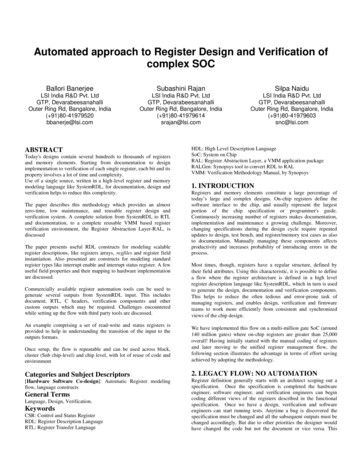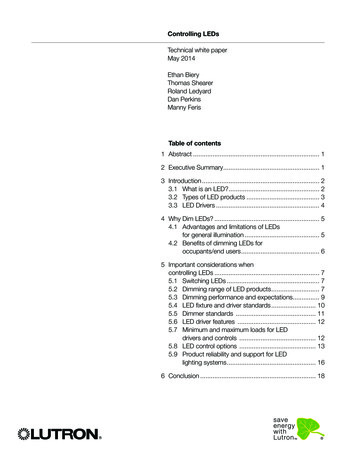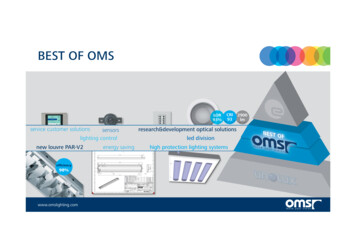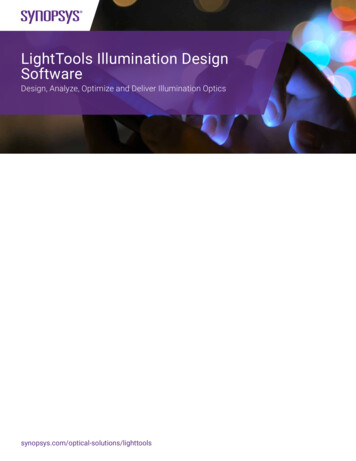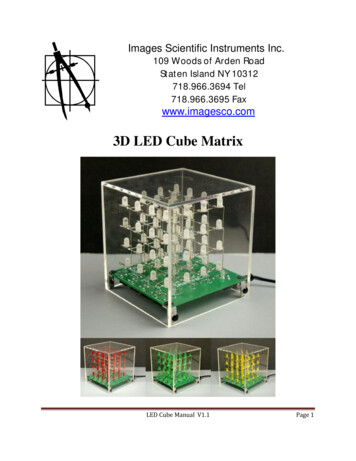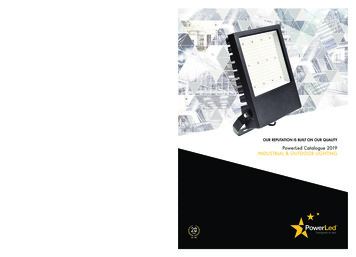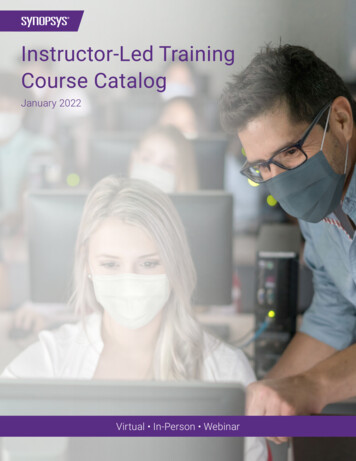
Transcription
Instructor-Led TrainingCourse CatalogJanuary 2022Virtual In-Person Webinar
General disclaimerThis document presents details about the training offerings from Synopsys at the time of its creation. Synopsys has used reasonableefforts to ensure that the information provided in this document is accurate and up-to-date, but details and offerings are subject tochange.This document contains confidential information about Synopsys and its businesses. Copies of this document may only be provided, anddisclosure of the information contained in it may only be made, with written prior agreement from Synopsys.Ownership and disposalThe information contained in this document is owned by Synopsys. The recipient shall dispose of the data as confidential waste and/orreturn the document to Synopsys upon request.The Synopsys differenceSynopsys helps development teams build secure, high-quality software, minimizing risks while maximizing speed and productivity.Synopsys, a recognized leader in application security, provides static analysis, software composition analysis, and dynamic analysissolutions that enable teams to quickly find and fix vulnerabilities and defects in proprietary code, open source components, andapplication behavior.For more information about the SynopsysSoftware Integrity Group, visit us online atwww.synopsys.com/software.Synopsys, Inc.185 Berry Street, Suite 6500San Francisco, CA 94107 USAInstructor-Led Training Catalog January 2022U.S. Sales: 800.873.8193International Sales: 1 415.321.5237Email: sig-info@synopsys.com synopsys.com
Table of contentsIntroduction . . . . . . . . . . . . . . . . . . . . . . . . . . . . . . . . . . . . . . . . . . . . . . . . . . . . . . . . . . . . . . . . . . . . . . . . . . . . . . . . . . . . . . . . . 5Our Curriculum. . . . . . . . . . . . . . . . . . . . . . . . . . . . . . . . . . . . . . . . . . . . . . . . . . . . . . . . . . . . . . . . . . . . . . . . . . . . . . . . . . . . . . . 5Delivery Models. . . . . . . . . . . . . . . . . . . . . . . . . . . . . . . . . . . . . . . . . . . . . . . . . . . . . . . . . . . . . . . . . . . . . . . . . . . . . . . . . . . . . . 6Fundamentals. . . . . . . . . . . . . . . . . . . . . . . . . . . . . . . . . . . . . . . . . . . . . . . . . . . . . . . . . . . . . . . . . . . . . . . . . . . 7Principles of Software Security. . . . . . . . . . . . . . . . . . . . . . . . . . . . . . . . . . . . . . . . . . . . . . . . . . . . . . . . . . . . . . . . . . . . . . . . . 8Attack and Defense. . . . . . . . . . . . . . . . . . . . . . . . . . . . . . . . . . . . . . . . . . . . . . . . . . . . . . . . . . . . . . . . . . . . . . . . . . . . . . . . . . . 9OWASP Top 10. . . . . . . . . . . . . . . . . . . . . . . . . . . . . . . . . . . . . . . . . . . . . . . . . . . . . . . . . . . . . . . . . . . . . . . . . . . . . . . . . . . . . . 10Webinars. . . . . . . . . . . . . . . . . . . . . . . . . . . . . . . . . . . . . . . . . . . . . . . . . . . . . . . . . . . . . . . . . . . . . . . . . . . . . . . . . . . . . . . . . . . 11Authentication and Authorization. . . . . . . . . . . . . . . . . . . . . . . . . . . . . . . . . . . . . . . . . . . . . . . . . . . . . . . . . . 12Securing APIs Using OAuth 2.0. . . . . . . . . . . . . . . . . . . . . . . . . . . . . . . . . . . . . . . . . . . . . . . . . . . . . . . . . . . . . . . . . . . . . . . . 13Securing SAML. . . . . . . . . . . . . . . . . . . . . . . . . . . . . . . . . . . . . . . . . . . . . . . . . . . . . . . . . . . . . . . . . . . . . . . . . . . . . . . . . . . . . . 14Webinars. . . . . . . . . . . . . . . . . . . . . . . . . . . . . . . . . . . . . . . . . . . . . . . . . . . . . . . . . . . . . . . . . . . . . . . . . . . . . . . . . . . . . . . . . . . 15Mobile. . . . . . . . . . . . . . . . . . . . . . . . . . . . . . . . . . . . . . . . . . . . . . . . . . . . . . . . . . . . . . . . . . . . . . . . . . . . . . . . 16Defending Android. . . . . . . . . . . . . . . . . . . . . . . . . . . . . . . . . . . . . . . . . . . . . . . . . . . . . . . . . . . . . . . . . . . . . . . . . . . . . . . . . . . 17Defending iOS. . . . . . . . . . . . . . . . . . . . . . . . . . . . . . . . . . . . . . . . . . . . . . . . . . . . . . . . . . . . . . . . . . . . . . . . . . . . . . . . . . . . . . . 18Securing Mobile Platforms 101. . . . . . . . . . . . . . . . . . . . . . . . . . . . . . . . . . . . . . . . . . . . . . . . . . . . . . . . . . . . . . . . . . . . . . . .19Securing Mobile Platforms 201. . . . . . . . . . . . . . . . . . . . . . . . . . . . . . . . . . . . . . . . . . . . . . . . . . . . . . . . . . . . . . . . . . . . . . . .20Cloud Platforms . . . . . . . . . . . . . . . . . . . . . . . . . . . . . . . . . . . . . . . . . . . . . . . . . . . . . . . . . . . . . . . . . . . . . . . . 21Securing Azure. . . . . . . . . . . . . . . . . . . . . . . . . . . . . . . . . . . . . . . . . . . . . . . . . . . . . . . . . . . . . . . . . . . . . . . . . . . . . . . . . . . . . . 22Securing AWS. . . . . . . . . . . . . . . . . . . . . . . . . . . . . . . . . . . . . . . . . . . . . . . . . . . . . . . . . . . . . . . . . . . . . . . . . . . . . . . . . . . . . . . 23Securing Containers With Docker. . . . . . . . . . . . . . . . . . . . . . . . . . . . . . . . . . . . . . . . . . . . . . . . . . . . . . . . . . . . . . . . . . . . . . 24Webinar. . . . . . . . . . . . . . . . . . . . . . . . . . . . . . . . . . . . . . . . . . . . . . . . . . . . . . . . . . . . . . . . . . . . . . . . . . . . . . . . . . . . . . . . . . . . 25Defensive Strategies. . . . . . . . . . . . . . . . . . . . . . . . . . . . . . . . . . . . . . . . . . . . . . . . . . . . . . . . . . . . . . . . . . . . 26Securing Open Source . . . . . . . . . . . . . . . . . . . . . . . . . . . . . . . . . . . . . . . . . . . . . . . . . . . . . . . . . . . . . . . . . . . . . . . . . . . . . . . 27Securing Software With DevSecOps . . . . . . . . . . . . . . . . . . . . . . . . . . . . . . . . . . . . . . . . . . . . . . . . . . . . . . . . . . . . . . . . . . . 28Webinars. . . . . . . . . . . . . . . . . . . . . . . . . . . . . . . . . . . . . . . . . . . . . . . . . . . . . . . . . . . . . . . . . . . . . . . . . . . . . . . . . . . . . . . . . . . 29Instructor-Led Training Catalog January 2022 synopsys.com
Languages and Platforms. . . . . . . . . . . . . . . . . . . . . . . . . . . . . . . . . . . . . . . . . . . . . . . . . . . . . . . . . . . . . . . 30Defending COBOL . . . . . . . . . . . . . . . . . . . . . . . . . . . . . . . . . . . . . . . . . . . . . . . . . . . . . . . . . . . . . . . . . . . . . . . . . . . . . . . . . . . 31Defending C# ASP.NET. . . . . . . . . . . . . . . . . . . . . . . . . . . . . . . . . . . . . . . . . . . . . . . . . . . . . . . . . . . . . . . . . . . . . . . . . . . . . . . 32Defending C/C . . . . . . . . . . . . . . . . . . . . . . . . . . . . . . . . . . . . . . . . . . . . . . . . . . . . . . . . . . . . . . . . . . . . . . . . . . . . . . . . . . . . 33Defending GoLang. . . . . . . . . . . . . . . . . . . . . . . . . . . . . . . . . . . . . . . . . . . . . . . . . . . . . . . . . . . . . . . . . . . . . . . . . . . . . . . . . . . 34Defending HTML. . . . . . . . . . . . . . . . . . . . . . . . . . . . . . . . . . . . . . . . . . . . . . . . . . . . . . . . . . . . . . . . . . . . . . . . . . . . . . . . . . . . 35Defending Java Enterprise Edition (EE). . . . . . . . . . . . . . . . . . . . . . . . . . . . . . . . . . . . . . . . . . . . . . . . . . . . . . . . . . . . . . . . . 36Defending Java SE. . . . . . . . . . . . . . . . . . . . . . . . . . . . . . . . . . . . . . . . . . . . . . . . . . . . . . . . . . . . . . . . . . . . . . . . . . . . . . . . . . . 37Defending JavaScript (No Framework). . . . . . . . . . . . . . . . . . . . . . . . . . . . . . . . . . . . . . . . . . . . . . . . . . . . . . . . . . . . . . . . . 38Defending JavaScript Angular. . . . . . . . . . . . . . . . . . . . . . . . . . . . . . . . . . . . . . . . . . . . . . . . . . . . . . . . . . . . . . . . . . . . . . . . . 39Defending JavaScript AngularJS . . . . . . . . . . . . . . . . . . . . . . . . . . . . . . . . . . . . . . . . . . . . . . . . . . . . . . . . . . . . . . . . . . . . . . 40Defending JavaScript React . . . . . . . . . . . . . . . . . . . . . . . . . . . . . . . . . . . . . . . . . . . . . . . . . . . . . . . . . . . . . . . . . . . . . . . . . . 41Defending Python With Django. . . . . . . . . . . . . . . . . . . . . . . . . . . . . . . . . . . . . . . . . . . . . . . . . . . . . . . . . . . . . . . . . . . . . . . . 42Defending Python With Flask . . . . . . . . . . . . . . . . . . . . . . . . . . . . . . . . . . . . . . . . . . . . . . . . . . . . . . . . . . . . . . . . . . . . . . . . . 43Defending .NET Core. . . . . . . . . . . . . . . . . . . . . . . . . . . . . . . . . . . . . . . . . . . . . . . . . . . . . . . . . . . . . . . . . . . . . . . . . . . . . . . . . 44Attacking Strategies. . . . . . . . . . . . . . . . . . . . . . . . . . . . . . . . . . . . . . . . . . . . . . . . . . . . . . . . . . . . . . . . . . . . 45Attacking Code using Static Analysis. . . . . . . . . . . . . . . . . . . . . . . . . . . . . . . . . . . . . . . . . . . . . . . . . . . . . . . . . . . . . . . . . . . 46Attacking Networks. . . . . . . . . . . . . . . . . . . . . . . . . . . . . . . . . . . . . . . . . . . . . . . . . . . . . . . . . . . . . . . . . . . . . . . . . . . . . . . . . . 47Attacking Web Applications. . . . . . . . . . . . . . . . . . . . . . . . . . . . . . . . . . . . . . . . . . . . . . . . . . . . . . . . . . . . . . . . . . . . . . . . . . . 48Hackathon. . . . . . . . . . . . . . . . . . . . . . . . . . . . . . . . . . . . . . . . . . . . . . . . . . . . . . . . . . . . . . . . . . . . . . . . . . . . . . . . . . . . . . . . . . 49Red Teaming. . . . . . . . . . . . . . . . . . . . . . . . . . . . . . . . . . . . . . . . . . . . . . . . . . . . . . . . . . . . . . . . . . . . . . . . . . . . . . . . . . . . . . . . 50Webinar. . . . . . . . . . . . . . . . . . . . . . . . . . . . . . . . . . . . . . . . . . . . . . . . . . . . . . . . . . . . . . . . . . . . . . . . . . . . . . . . . . . . . . . . . . . . 51Requirements, Architecture, and Training . . . . . . . . . . . . . . . . . . . . . . . . . . . . . . . . . . . . . . . . . . . . . . . . . . . 52Threat Modeling. . . . . . . . . . . . . . . . . . . . . . . . . . . . . . . . . . . . . . . . . . . . . . . . . . . . . . . . . . . . . . . . . . . . . . . . . . . . . . . . . . . . . 53Embedded and IoT. . . . . . . . . . . . . . . . . . . . . . . . . . . . . . . . . . . . . . . . . . . . . . . . . . . . . . . . . . . . . . . . . . . . . 54Embedded Systems Security. . . . . . . . . . . . . . . . . . . . . . . . . . . . . . . . . . . . . . . . . . . . . . . . . . . . . . . . . . . . . . . . . . . . . . . . . .55Product Training . . . . . . . . . . . . . . . . . . . . . . . . . . . . . . . . . . . . . . . . . . . . . . . . . . . . . . . . . . . . . . . . . . . . . . . 56Coverity Server Administration Essentials . . . . . . . . . . . . . . . . . . . . . . . . . . . . . . . . . . . . . . . . . . . . . . . . . . . . . . . . . . . . . . 57Coverity Build Administration Essentials . . . . . . . . . . . . . . . . . . . . . . . . . . . . . . . . . . . . . . . . . . . . . . . . . . . . . . . . . . . . . . . 58Coverity Essentials for End Users . . . . . . . . . . . . . . . . . . . . . . . . . . . . . . . . . . . . . . . . . . . . . . . . . . . . . . . . . . . . . . . . . . . . . 59Defensics Essentials. . . . . . . . . . . . . . . . . . . . . . . . . . . . . . . . . . . . . . . . . . . . . . . . . . . . . . . . . . . . . . . . . . . . . . . . . . . . . . . . . 60Black Duck Essentials. . . . . . . . . . . . . . . . . . . . . . . . . . . . . . . . . . . . . . . . . . . . . . . . . . . . . . . . . . . . . . . . . . . . . . . . . . . . . . . . 61Instructor-Led Training Catalog January 2022 synopsys.com
IntroductionSynopsys' broad range of software security products and professional services affords us the unique position to create, maintain, anddeliver the best software security training for our customers. Our instructional design process puts practicing consultants in charge ofcourses in their respective areas of expertise. Course owners use their experience in solving customers’ challenges to inform coursedirection. Similarly, we use certified practicing consultants as instructors. Instructors are able to share real-life examples from previouscustomer interactions with the students.What this means to you is that our courses aren’t just textbook best practices; our courses have experience baked in from design throughdelivery.Synopsys is also the creator and leader of the BSIMM (https://www.bsimm.com) and BSIMM community. Insights from the BSIMM, aswell as from BSIMM assessors, influence both course and catalog direction. Feedback from the community is swiftly incorporated toensure our courses are relevant for development and security teams.Our CurriculumSynopsys’ curriculum is a series of complementary courses designed to meet your organization’s needs. You can select the courses thatbest match your audience’s level of experience, roles, and development platforms.Our courses are grouped into the following software security activities: Fundamentals: Your software security journey starts here. Fundamentals courses are designed to get you started. Authentication and Authorization: Securely using modern federated authentication and authorization frameworks frees yourapplication team to focus on functionality while shifting some risk to third parties. Learn security best practices for using frameworkssuch as OAuth and SAML. Cloud Platforms: Just because your application makes use of cloud providers for hosting doesn’t automatically mean the applicationis deployed securely. The settings and options for deployment can be daunting for developers and operations new to the cloudenvironment. Securely configuring the deployment is vital to the security of your customers and data. Defensive Strategies: Software development and deployment is happening at a blistering pace. To ensure software is not being sentout the door with security defects processes must be put in place to ensure the software is tested thoroughly as the software winds itsway through the development process. Courses in defensive strategies ensure that the latest best practices are being deployed in yourenvironment. Attacking Strategies: Understanding how adversaries look for weaknesses in our software is key to building security in. These coursesare designed to help you put on your proverbial malicious hat. Languages and Platforms: Knowing the weaknesses in your chosen language or platform is the only way to avoid those weaknessesthat lead to security vulnerabilities. Languages and Platforms highlight those weaknesses then show you how to avoid them usingindustry best practices. Mobile: Your application will be downloaded and installed on thousands of devices. Are you sure you’ve implemented the correctsecurity features? Explore what features should be enabled and when to secure your mobile applications. Requirements, Architecture, and Training: The earliest stages of the SDLC are requirements, architecture, and training. Courses in thiscategory are designed to help you catch security problems early when they are easiest and cheapest to fix. Product Training: Learn how to use Synopsys products with a live instructor guiding your way.Instructor-Led Training Catalog January 2022 synopsys.com 5
Delivery ModelsVirtual, In-Person, or Webinar: Your ChoiceIf you have a distributed workforce, your participants can avoid travel and time away from theoffice using our Virtual Instructor-Led Training (vILT). vILT is separated into shorter sessions tooptimize participant engagement. vILT can be delivered over consecutive working days or on aweekly basis depending on your team's preference. Virtual training is a cost-conscious trainingdelivery method for supporting your employees' professional development while workingremotely. Our instructors are trained to engage your audience through group discussion andinteractive hand-on labs designed to simulate real-world environments. Instructors can makecourse adjustments to better complement the needs, interests, and experience level of yourparticipants.Synopsys uses a number oftraining strategies to assistin participant engagement,including hand-on labsusing our cloud-based VMsolution, breakout groups,live demonstrations, whiteboarding, videos, and polling.If you prefer traditional instructor-led training, our certified instructors will travel to the locationof your choice.Webinars allow you to reach a large number of participants in a short amount of time. Typicallyaround an hour in length with no attendance cap, use webinars to introduce new topics to yourentire workforce or meet an annual training requirement.Instructor-led courses are held on your schedule in the format that works best for you.VIRTUAL ILTCLASSROOM ILTWEBINARInstructor typeFull-time securityprofessionalFull-time securityprofessionalFull-time securityprofessionalActivitiesHands-on labsHands-on labsDemonstrationsStudent materialsDigitalDigitalOn requestLocation ofstudentsDistributed andremoteOn-siteDistributed andremoteDeliveredGloballyGloballyGloballyTravel costs 0.00Varies 0.00Number ofstudents supportedUp to 20Up to 2020-200Training talogTailored by requestTraining duration8 hours acrossmultiple days8 hours in one day1-2 hoursInstructor-Led Training Catalog January 2022 synopsys.com 6
IntroductoryNew in 2022Intended Audience Developers DevSecOps ArchitectsDelivery Format Traditional Classroom Virtual ClassroomClass Duration 8 hoursPrinciples of Software Securityfor COBOLDescriptionThe Securing Web Services course is intended for developers, engineers, and architects whowork with backend web services APIs which may not necessarily have a User Interface (UI) ora UI component.This course examines web services concepts and then takes a deep dive into several webservices technologies such as WS-Security, Security Assertion Markup Language (SAML),and OAuth. This course also covers risks inherent to web services and how to properly threatmodel web services. Web service security is examined from the perspective of the message,the channel, and the service itself. The lab component of this course allows students to gainan understanding of and practice with some of the real-world security issues inherent to webservices.The lab is intentionally written with a programming language and framework that are popularbut with which most developers are not familiar: Python and Flask. This allows students tofocus on secure design and secure coding concepts without being too concerned with theimplementation details of a particular language.This is a comprehensive and stand-alone course on web services. Many concepts taughtin this course are covered in depth in other courses, such as Threat Modeling and OAuth. Ifyou are building a multi-day curriculum for web service developers, please reach out to theSynopsys training team for advice on course selection.FundamentalsInstructor-Led Training Catalog January 2022 synopsys.com 7
FundamentalsIntended Audience ArchitectsDevelopersQA EngineersSecurity PractitionersDelivery Format Traditional Classroom Virtual ClassroomClass Duration 8 hoursCourse Objectives for theIntroduction ModuleAt the end of this course, you willbe able to: Recognize the importance ofsoftware security Identify the obstacles thatsoftware security faces Understand the characteristicsof a successful softwaresecurity initiative Describe key software securityactivitiesCourse Objectives for theRequirements ModuleAt the end of this course, you willbe able to: Recognize common attacks onsoftware Recognize common solutionsand patterns to mitigateattacks on data, functionality,and resources Recognize securityrequirements to mitigatecommon vulnerabilitiesPrinciples of Software SecurityThe Principles of Software Security course provides the foundation to inspire developers andother team members to start taking security seriously. This modular course can be deliveredas a full-day offering, or depending on your needs, can be focused on one of the primarymodules as a half-day course.Introduction moduleThe half-day Introduction module first identifies current software security problems, and thenaddresses the issues by explaining how to infuse software security into the developmentprocess early on. This module elucidates the Synopsys concept of “Building Security In” asopposed to relying solely on traditional security and testing practices. Basic software security concepts: Topics include a software security vocabulary, obstaclesto software security, how to build security in, and the importance of a software securityinitiative (SSI) Fundamentals of a SSI: SSI scope, goals, engineering and guidance, vendor management,software security groups (SSGs), strategy, training, compliance, and metrics Software security engineering: Three pillars of risk management, touchpoints, andknowledge, security standards, and training, and how to integrate this learning with yourWaterfall or Agile development approachLabs Security hurdles in an ever-connected world of malicious actors– Think like an attacker by considering data, network, and functionality of the device Identify the best defect discovery techniques– Scenario: Starting down the road– Scenario: We can do more!– Scenario: Building security inRequirements moduleThe Requirements half-day module focuses on introducing important cost-saving softwaresecurity requirements early in the software development life cycle. Students learn the detailsof and the causes behind secure coding errors and mistakes in this data-centric module, andhow these software security defects are exploited. They will also learn the practices that helpprevent the most common mistakes. Essential use cases: Access control requirements for authentication and authorization Resource management: Ways to protect resources and prevent attacks such as denial ofservice and resource management guidelines Data life cycle: Data protection at every stage of data interpretation (data in use, data at rest,and data in motion), as well as data input, processing, and output, improper input validation,input validation approaches and guidance, log injection, output encoding, safe error handling,protecting the cache, masking sensitive data, and encryptionLab Security requirements for use cases:– Authentication– Authorization– Resource management– Data interpretation– Data in use– Data in motion– Data at restInstructor-Led Training Catalog January 2022 synopsys.com 8
FundamentalsIntended Audience ArchitectsDevelopersQA EngineersSecurity PractitionersDelivery Format Traditional Classroom Virtual ClassroomClass Duration 8 hoursCourse ObjectivesAt the end of this course, you willbe able to: Recognize common attacks onsoftware Recognize common solutionsand patterns for mitigatingthese attacks Recognize how to avoidcommon vulnerabilitiesAttack and DefenseThe Attack and Defense course provides software builders and testers an in-depth look atstandard attacks and their corresponding defenses. Students successfully completing thiscourse are empowered to solve tricky problems securely in their own environment by mappingthem to known problems and tried-and-tested solutions.This course introduces common attacks that can be happen to most applications. Theseattacks are also seen in different contexts such as web, embedded, thick client, or mobile, andtheir standard solutions are discussed in the classroom. Students are then guided to apply thisknowledge to identify attacks and design defenses for a model application throughout the labs.Protecting dataThis section examines the life cycle stages of data, identifies common attacks for each stage,and explains how to handle common use cases securely. Data at rest (online and offline attacks): Exploring common ways of storing data, and theassociated attacks targeted to reveal otherwise inaccessible information Data in motion: Exploring common communication implementations between components,and attacks that can be performed to eavesdrop on, replay, or modify data Data interpretation: Exploring the difference between control and data planes, how theyrequire different approaches of interpretation, and examples of resulting attacks andcountermeasures Data in use: Exploring attacks on the underlying software, hardware stacks, and physicalworld environments that can leak dataAccess controlThis section discusses authentication and authorization, and looks at common methods ofidentifying a system user and ways of hijacking that identity. It also examines the controlsused to split and combine permissions to achieve business goals while following the principleof least privilege. And it includes a discussion about the importance of keeping audit logs.Resource managementThis section highlights the importance of software performance considerations in the contextof intentional misuse and abuse. How much stress can a malicious user put on the system?Does that user always require a rich pool of resources to do so?Open source softwareRisks from open source software are discussed in this section, including: Open source software use Common attacks Standard defenses Common pitfallsLabs Password hash cracking: Students run a password hacking program calledJohn the Ripper (JtR). SSL scan: Students use a free tool called Qualys SSL Scan to test the security strength of anSSL certificate used to encrypt communication of a website. Intercept HTTP request/response: Students examine one of the most important tools of websecurity testing: the local HTTP proxy. Session ID entropy: Students look at the entropy of the session ID in the Bank of InsecuritiesInstructor-Led Training Catalog January 2022 synopsys.com 9
FundamentalsOWASP Top 10Available March 2022Intended Audience ArchitectsDevelopersQA EngineersSecurity PractitionersDelivery Format Traditional Classroom Virtual ClassroomClass Duration 8 hoursCourse ObjectivesAt the end of this course, you willbe able to: Understand the flaws andweaknesses covered in theOWASP Top 10 Understand how attackersexploit these flaws andweaknesses Understand how to protectagainst these issues in yourapplications by applying saferdesign patterns, coding, andtesting practicesThis course focuses on the most important security defects found in web applications, coveringall issues in the latest OWASP Top 10 list. Each topic describes a vulnerability and providesguidance for remediation. This course also provides demonstrations and practical hands-onexercises where students learn what impact these security issues can have on web applications.What is the OWASP Top 10?Taxonomies provide a common vocabulary for professionals to use when discussing softwaresecurity vulnerabilities. The OWASP Top Ten list is the most widely used taxonomy for webapplication security. The OWASP Top Ten covers the most critical web application securitydefects. It is created by security experts from around the world who have shared theirexpertise to produce this list.OWASP Top 10This is the main section and covers the 10 most critical web application security risks, asdefined in the latest OWASP Top 10: A01 Broken Access Control– Authentication vs. authorization, privilege escalation, tampering A02 Cryptographic Failures– Failures related to cryptography often leading to sensitive data exposure or systemcompromise A03 Injection– Dangers of mixing data with code– Cross-Site Scripting resulting from unencoded, unvalidated, and untrusted user-supplied data A04 Insecure Design– Risks related to design flaws– Adding the required controls to your system to build a solid foundation for the rest ofyour application stack since security holes can exist in your application even before youwrite a single line of code A05 Security Misconfiguration– Misconfigured servers, lack of knowledge on installed features– Specific type of Server-Side Request Forgery (SSRF) attack A06 Vulnerable and Outdated Components– Why and how does this happen? A07 Identification and Authentication Failures– Broken authentication and session management A08 Software and Data Integrity Failures– Regarding assumptions related to software updates, critical data, and CI/CD pipelineswithout verifying integrity– Causes of deserialized vulnerabilities A09 Security Logging and Monitoring Failures– Secure logging and monitoring A10 Server-Side Request Forgery (SSRF)– Dangers of remote resources specified by user inputReferences and Next StepsThis section provides information on how to proceed next. Topics covered include: BSIMM—Measure Your Development Practices Secure Software Development Lifecycle Coding Standard Security Unit Tests Security Integration Tests Automated Security AnalysisLabs and DemosThis course includes a variety of labs and demos for students to practice their skills.Instructor-Led Training Catalog January 2022 synopsys.com 10
FundamentalsWebinarsIntended AudienceSoftware Security 101 DevelopersArchitectsDBAsQA EngineersManagersThis webinar introduces software security fundamentals, their importance, and businessimpact. It elaborates on activities that are leveraged to build and maintain secure software.It also includes a high-level overview of some of the more common web applicationvulnerabilities, their causes, and how they can be prevented.Delivery Format Virtual ClassroomClass Duration 1 hourCourse Objectives Software Security 101:Understand the fundamentalsof a software security initiative(SSI) Annual Security Awareness:
security requirements early in the software development life cycle. Students learn the details of and the causes behind secure coding errors and mistakes in this data-centric module, and how these software security defects are exploited. They will also learn the practices that help prevent the most common mistakes.

